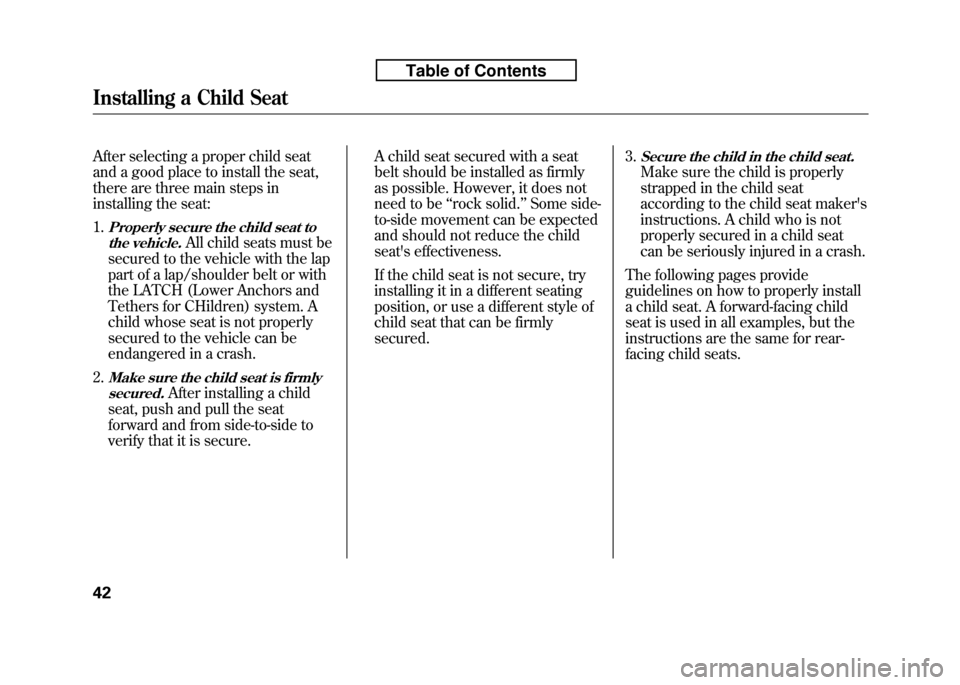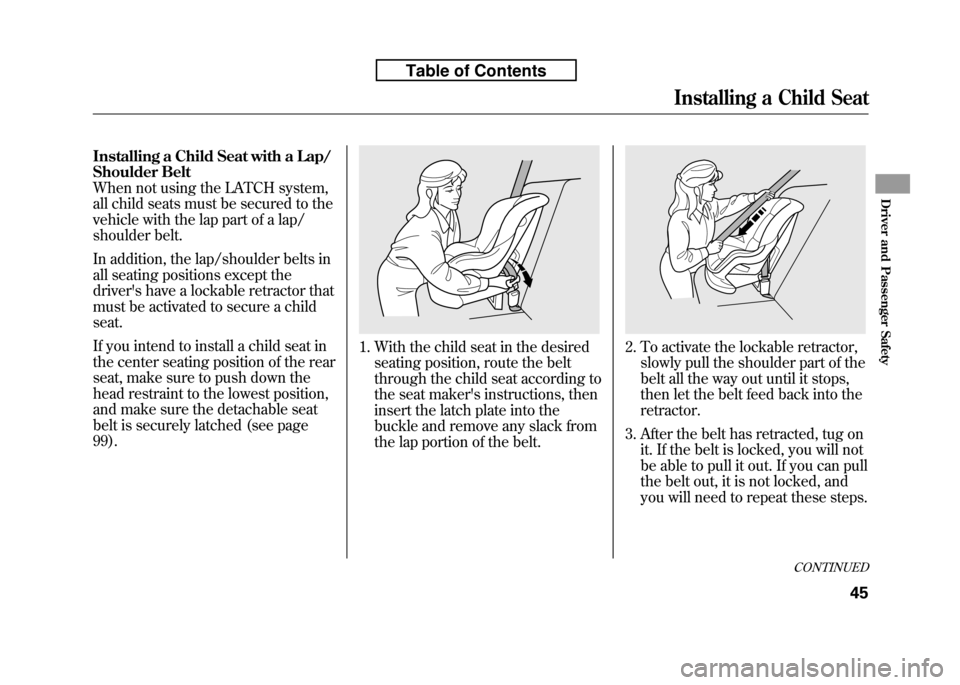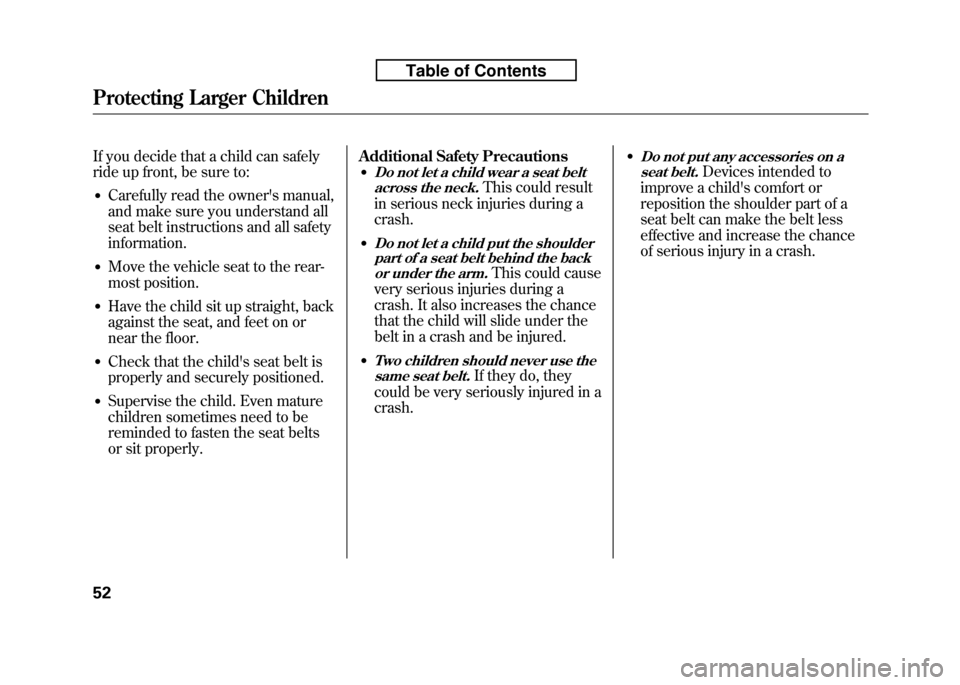Page 58 of 351

After selecting a proper child seat
and a good place to install the seat,
there are three main steps in
installing the seat: 1.
Properly secure the child seat tothe vehicle.
All child seats must be
secured to the vehicle with the lap
part of a lap/shoulder belt or with
the LATCH (Lower Anchors and
Tethers for CHildren) system. A
child whose seat is not properly
secured to the vehicle can be
endangered in a crash.
2.
Make sure the child seat is firmly secured.
After installing a child
seat, push and pull the seat
forward and from side-to-side to
verify that it is secure. A child seat secured with a seat
belt should be installed as firmly
as possible. However, it does not
need to be
‘‘rock solid. ’’Some side-
to-side movement can be expected
and should not reduce the child
seat's effectiveness.
If the child seat is not secure, try
installing it in a different seating
position, or use a different style of
child seat that can be firmlysecured. 3.
Secure the child in the child seat.
Make sure the child is properly
strapped in the child seat
according to the child seat maker's
instructions. A child who is not
properly secured in a child seat
can be seriously injured in a crash.
The following pages provide
guidelines on how to properly install
a child seat. A forward-facing child
seat is used in all examples, but the
instructions are the same for rear-
facing child seats.
Installing a Child Seat
42
Table of Contents
Page 59 of 351
Installing a Child Seat with LATCH
Your vehicle is equipped with
LATCH (Lower Anchors and Tethers
for CHildren) at the outer rear seats.
The lower anchors are located
between the seat-back and seat
bottom, and are to be used only with
a child seat designed for use withLATCH.
The location of each lower anchor is
indicated by a small button above the
anchor point.
You can find lower anchors in the
slits in the seat-backs.
To install a LATCH-compatible child seat:
1. Move the seat belt buckle ortongue away from the lower anchors.
2. Make sure there are no objects near the anchors that could
prevent a secure connection
between the child seat and the anchors.3. Place the child seat on the vehicleseat, then attach the seat to the
lower anchors according to the
child seat maker's instructions.
Some LATCH-compatible seats
have a rigid-type connector as
shown above.
LOWER ANCHORS
BUTTON
Rigid type
CONTINUED
Installing a Child Seat
43
Driver and Passenger Safety
Table of Contents
Page 60 of 351
Other LATCH-compatible seats
have a flexible-type connector as
shown above.
4. Whatever type you have, follow the child seat maker's instructions for
adjusting or tightening the fit.5. Lift the head restraint (see page94), then route the tether strap
through the legs of the head
restraint and over the seat-back,
making sure the strap is nottwisted.6. Attach the tether strap hook to theanchor, then tighten the strap as
instructed by the child seat maker.
If the tether strap is too long and
cannot be tightened firmly, find a
route where the strap can be
tightened securely.
7. Push and pull the child seat forward and from side-to-side to
verify that it is secure.
Flexible type
ANCHOR
TETHER STRAP HOOK
Installing a Child Seat
44
Table of Contents
Page 61 of 351

Installing a Child Seat with a Lap/
Shoulder Belt
When not using the LATCH system,
all child seats must be secured to the
vehicle with the lap part of a lap/
shoulder belt.
In addition, the lap/shoulder belts in
all seating positions except the
driver's have a lockable retractor that
must be activated to secure a childseat.
If you intend to install a child seat in
the center seating position of the rear
seat, make sure to push down the
head restraint to the lowest position,
and make sure the detachable seat
belt is securely latched (see page99).
1. With the child seat in the desiredseating position, route the belt
through the child seat according to
the seat maker's instructions, then
insert the latch plate into the
buckle and remove any slack from
the lap portion of the belt.2. To activate the lockable retractor,slowly pull the shoulder part of the
belt all the way out until it stops,
then let the belt feed back into theretractor.
3. After the belt has retracted, tug on it. If the belt is locked, you will not
be able to pull it out. If you can pull
the belt out, it is not locked, and
you will need to repeat these steps.
CONTINUED
Installing a Child Seat
45
Driver and Passenger Safety
Table of Contents
Page 62 of 351
4. After confirming that the belt islocked, grab the shoulder part of
the belt near the buckle, and pull
up to remove any slack from the
lap part of the belt. Remember, if
the lap part of the belt is not tight,
the child seat will not be secure.
To remove slack, it may help to put
weight on the child seat, or push
on the back of the seat while
pulling up on the belt.5. Push and pull the child seatforward and from side-to-side to
verify that it is secure enough to
stay upright during normal driving
maneuvers. If the child seat is not
secure, unlatch the belt, allow it to
retract fully, then repeat thesesteps. To deactivate the lockable retractor
and remove a child seat, unlatch the
buckle, unroute the seat belt, and let
the belt fully retract.
Installing a Child Seat
46
Table of Contents
Page 63 of 351
Installing a Child Seat with a Tether
A child seat with a tether can be
installed in any seating position in
the back seat.
Each rear outside seating position
has an anchorage point on the seat-
back, and the center seating position
has an anchorage point in the ceiling
near the tailgate.
Since a tether can provide additional
security to the lap/shoulder belt
installation, we recommend using a
tether whenever one is required oravailable.Using an Outer Anchor
1. After properly securing the childseat (see page 45), lift the head
restraint, then route the tether
strap over the seat-back and
through the head restraint legs.
2. Attach the tether strap hook to theanchor, making sure the tether
strap is not twisted.
3. Tighten the strap according to the seat maker's instructions.
ANCHOR
TETHER STRAP HOOK ANCHOR
CONTINUED
Installing a Child Seat
47
Driver and Passenger Safety
Table of Contents
Page 64 of 351
Using the Center Anchor
1. Lower the head restraint to itslowest position.
2. After properly securing the child seat (see page 45), open the
anchor cover.
3. Route the tether strap over thehead restraint, then attach the
tether strap hook to the anchor,
making sure the tether strap is nottwisted.
4. Tighten the strap according to the seat maker's instructions.
ANCHOR
COVER
ANCHOR
TETHER STRAP HOOK
Installing a Child Seat
48
Table of Contents
Page 68 of 351

If you decide that a child can safely
ride up front, be sure to:● Carefully read the owner's manual,
and make sure you understand all
seat belt instructions and all safety information.
● Move the vehicle seat to the rear-
most position.
● Have the child sit up straight, back
against the seat, and feet on or
near the floor.
● Check that the child's seat belt is
properly and securely positioned.
● Supervise the child. Even mature
children sometimes need to be
reminded to fasten the seat belts
or sit properly. Additional Safety Precautions
●
Do not let a child wear a seat belt
across the neck.
This could result
in serious neck injuries during acrash.
●
Do not let a child put the shoulder part of a seat belt behind the back
or under the arm.
This could cause
very serious injuries during a
crash. It also increases the chance
that the child will slide under the
belt in a crash and be injured.
●
Two children should never use the same seat belt.
If they do, they
could be very seriously injured in acrash. ●
Do not put any accessories on a
seat belt.
Devices intended to
improve a child's comfort or
reposition the shoulder part of a
seat belt can make the belt less
effective and increase the chance
of serious injury in a crash.
Protecting Larger Children
52
Table of Contents